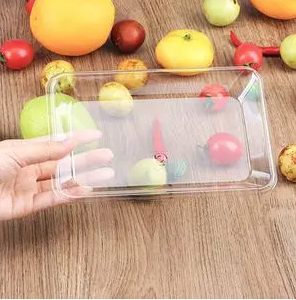What type of plastic is a plastic flat tray? It's a question that might seem simple, but the answer reveals a fascinating world of materials, design, and sustainability. The plastic flat tray, a ubiquitous item in our daily lives, comes in various forms and materials, each with its unique characteristics and environmental implications. In this essay, we delve into the world of plastic flat trays, exploring their types, applications, and the impact they have on our environment.

1. Polystyrene (PS) Plastic Flat Trays:
One common type of plastic flat tray is made from polystyrene, known as PS. These trays are lightweight, sturdy, and ideal for serving purposes. You've likely encountered them at fast-food restaurants, where they hold your meals or beverages. Polystyrene plastic flat trays are cost-effective and disposable, but they come with concerns about their environmental impact due to their slow decomposition rate.
2. Polyethylene (PE) Plastic Flat Trays:
Polyethylene, or PE, is another plastic commonly used for flat trays. These trays are versatile and can be found in various settings, from cafeterias to packaging in grocery stores. They are known for their durability, making them suitable for reuse. However, like many plastics, recycling PE trays can be challenging, contributing to plastic waste issues.
3. Polypropylene (PP) Plastic Flat Trays:
Polypropylene, or PP, plastic flat trays are gaining popularity for their versatility and resistance to heat. You might encounter them in microwaveable meal trays or as packaging for deli products. PP trays offer a balance between durability and environmental impact, as they can be recycled in some recycling programs.
4. PET Plastic Flat Trays:
Polyethylene terephthalate, or PET, plastic flat trays are commonly used in the food industry for packaging fruits, vegetables, and baked goods. PET is lightweight and transparent, allowing for better product visibility. While PET trays are recyclable and contribute to the circular economy, their environmental impact depends on the efficiency of recycling systems.
5. Environmental Concerns with Plastic Flat Trays:
The widespread use of plastic flat trays has raised concerns about their environmental footprint. These trays can take hundreds of years to decompose in landfills, contributing to plastic pollution. Single-use plastic flat trays, in particular, have come under scrutiny due to their contribution to the global plastic waste crisis.
Efforts to mitigate the environmental impact of plastic flat trays include recycling programs, the development of biodegradable alternatives, and consumer awareness campaigns. Some manufacturers are exploring sustainable materials, such as bioplastics, which have the potential to reduce the environmental impact of these trays.
Conclusion: Balancing Utility and Sustainability
The plastic flat tray is a versatile and practical tool that serves a wide range of purposes in our daily lives. However, its convenience often comes at an environmental cost. As we continue to grapple with the challenges of plastic waste and pollution, it is essential to consider the materials used in these trays and their end-of-life options.
While recycling and sustainable alternatives hold promise, consumer choices and responsible disposal play a crucial role in reducing the environmental impact of plastic flat trays. By making informed choices and advocating for sustainable practices, we can strike a balance between the utility of these trays and their impact on the planet. The plastic flat tray, with its versatility and ubiquity, serves as a microcosm of the larger conversation surrounding plastic use and sustainability in our modern world.
Comments
Please Join Us to post.
0